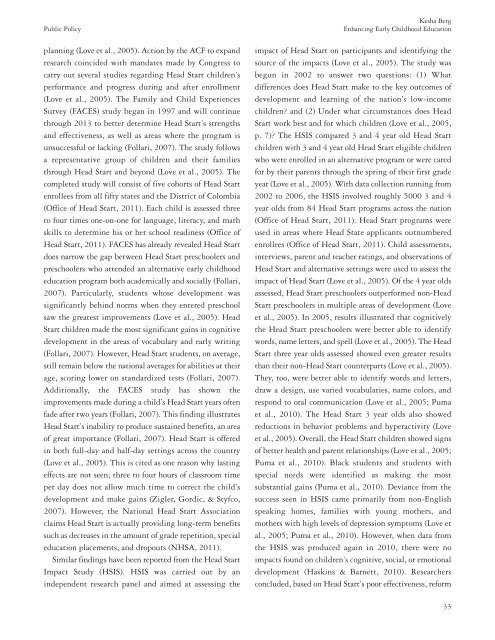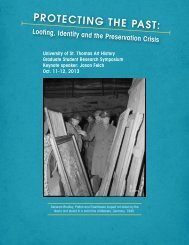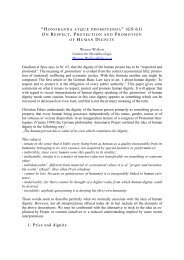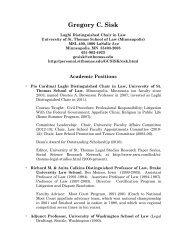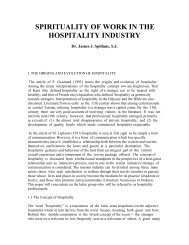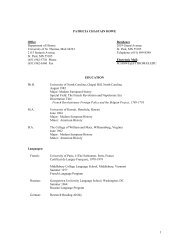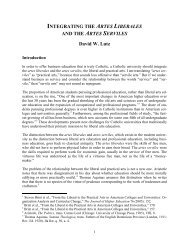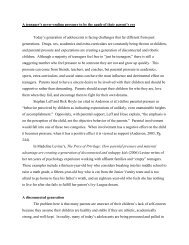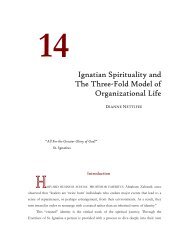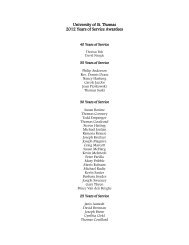dr. ronald e. mcnair acknowledgements - University of St. Thomas
dr. ronald e. mcnair acknowledgements - University of St. Thomas
dr. ronald e. mcnair acknowledgements - University of St. Thomas
Create successful ePaper yourself
Turn your PDF publications into a flip-book with our unique Google optimized e-Paper software.
Kesha Berg<br />
Public Policy Enhancing Early Childhood Education<br />
planning (Love et al., 2005). Action by the ACF to expand<br />
research coincided with mandates made by Congress to<br />
carry out several studies regarding Head <strong>St</strong>art chil<strong>dr</strong>en’s<br />
performance and progress during and after enrollment<br />
(Love et al., 2005). The Family and Child Experiences<br />
Survey (FACES) study began in 1997 and will continue<br />
through 2013 to better determine Head <strong>St</strong>art’s strengths<br />
and effectiveness, as well as areas where the program is<br />
unsuccessful or lacking (Follari, 2007). The study follows<br />
a representative group <strong>of</strong> chil<strong>dr</strong>en and their families<br />
through Head <strong>St</strong>art and beyond (Love et al., 2005). The<br />
completed study will consist <strong>of</strong> five cohorts <strong>of</strong> Head <strong>St</strong>art<br />
enrollees from all fifty states and the District <strong>of</strong> Colombia<br />
(Office <strong>of</strong> Head <strong>St</strong>art, 2011). Each child is assessed three<br />
to four times one-on-one for language, literacy, and math<br />
skills to determine his or her school readiness (Office <strong>of</strong><br />
Head <strong>St</strong>art, 2011). FACES has already revealed Head <strong>St</strong>art<br />
does narrow the gap between Head <strong>St</strong>art preschoolers and<br />
preschoolers who attended an alternative early childhood<br />
education program both academically and socially (Follari,<br />
2007). Particularly, students whose development was<br />
significantly behind norms when they entered preschool<br />
saw the greatest improvements (Love et al., 2005). Head<br />
<strong>St</strong>art chil<strong>dr</strong>en made the most significant gains in cognitive<br />
development in the areas <strong>of</strong> vocabulary and early writing<br />
(Follari, 2007). However, Head <strong>St</strong>art students, on average,<br />
still remain below the national averages for abilities at their<br />
age, scoring lower on standardized tests (Follari, 2007).<br />
Additionally, the FACES study has shown the<br />
improvements made during a child’s Head <strong>St</strong>art years <strong>of</strong>ten<br />
fade after two years (Follari, 2007). This finding illustrates<br />
Head <strong>St</strong>art’s inability to produce sustained benefits, an area<br />
<strong>of</strong> great importance (Follari, 2007). Head <strong>St</strong>art is <strong>of</strong>fered<br />
in both full-day and half-day settings across the country<br />
(Love et al., 2005). This is cited as one reason why lasting<br />
effects are not seen; three to four hours <strong>of</strong> classroom time<br />
per day does not allow much time to correct the child’s<br />
development and make gains (Zigler, Gordic, & <strong>St</strong>yfco,<br />
2007). However, the National Head <strong>St</strong>art Association<br />
claims Head <strong>St</strong>art is actually providing long-term benefits<br />
such as decreases in the amount <strong>of</strong> grade repetition, special<br />
education placements, and <strong>dr</strong>opouts (NHSA, 2011).<br />
Similar findings have been reported from the Head <strong>St</strong>art<br />
Impact <strong>St</strong>udy (HSIS). HSIS was carried out by an<br />
independent research panel and aimed at assessing the<br />
impact <strong>of</strong> Head <strong>St</strong>art on participants and identifying the<br />
source <strong>of</strong> the impacts (Love et al., 2005). The study was<br />
begun in 2002 to answer two questions: (1) What<br />
differences does Head <strong>St</strong>art make to the key outcomes <strong>of</strong><br />
development and learning <strong>of</strong> the nation’s low-income<br />
chil<strong>dr</strong>en? and (2) Under what circumstances does Head<br />
<strong>St</strong>art work best and for which chil<strong>dr</strong>en (Love et al., 2005,<br />
p. 7)? The HSIS compared 3 and 4 year old Head <strong>St</strong>art<br />
chil<strong>dr</strong>en with 3 and 4 year old Head <strong>St</strong>art eligible chil<strong>dr</strong>en<br />
who were enrolled in an alternative program or were cared<br />
for by their parents through the spring <strong>of</strong> their first grade<br />
year (Love et al., 2005). With data collection running from<br />
2002 to 2006, the HSIS involved roughly 5000 3 and 4<br />
year olds from 84 Head <strong>St</strong>art programs across the nation<br />
(Office <strong>of</strong> Head <strong>St</strong>art, 2011). Head <strong>St</strong>art programs were<br />
used in areas where Head <strong>St</strong>ate applicants outnumbered<br />
enrollees (Office <strong>of</strong> Head <strong>St</strong>art, 2011). Child assessments,<br />
interviews, parent and teacher ratings, and observations <strong>of</strong><br />
Head <strong>St</strong>art and alternative settings were used to assess the<br />
impact <strong>of</strong> Head <strong>St</strong>art (Love et al., 2005). Of the 4 year olds<br />
assessed, Head <strong>St</strong>art preschoolers outperformed non-Head<br />
<strong>St</strong>art preschoolers in multiple areas <strong>of</strong> development (Love<br />
et al., 2005). In 2005, results illustrated that cognitively<br />
the Head <strong>St</strong>art preschoolers were better able to identify<br />
words, name letters, and spell (Love et al., 2005). The Head<br />
<strong>St</strong>art three year olds assessed showed even greater results<br />
than their non-Head <strong>St</strong>art counterparts (Love et al., 2005).<br />
They, too, were better able to identify words and letters,<br />
<strong>dr</strong>aw a design, use varied vocabularies, name colors, and<br />
respond to oral communication (Love et al., 2005; Puma<br />
et al., 2010). The Head <strong>St</strong>art 3 year olds also showed<br />
reductions in behavior problems and hyperactivity (Love<br />
et al., 2005). Overall, the Head <strong>St</strong>art chil<strong>dr</strong>en showed signs<br />
<strong>of</strong> better health and parent relationships (Love et al., 2005;<br />
Puma et al., 2010). Black students and students with<br />
special needs were identified as making the most<br />
substantial gains (Puma et al., 2010). Deviance from the<br />
success seen in HSIS came primarily from non-English<br />
speaking homes, families with young mothers, and<br />
mothers with high levels <strong>of</strong> depression symptoms (Love et<br />
al., 2005; Puma et al., 2010). However, when data from<br />
the HSIS was produced again in 2010, there were no<br />
impacts found on chil<strong>dr</strong>en’s cognitive, social, or emotional<br />
development (Haskins & Barnett, 2010). Researchers<br />
concluded, based on Head <strong>St</strong>art’s poor effectiveness, reform<br />
33


